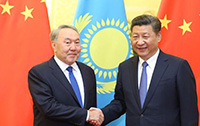The dynamics of modern Poland are evident on the streets
By Fu Jing (chinadaily.com.cn) Updated: 2016-06-19 17:41
 |
|
Warsaw Old Town. Provided to China Daily |
In my various interviews ahead of President Xi Jinping's visit to Poland, which started on Sunday, the dynamics of this central Europe country were frequently mentioned by prominent interviewees, ranging from Polish President Andrzej Duda, who is 44, to Chinese ambassador Xu Jian.

Wandering through the streets of Warsaw, eating hearty Polish food in traditional restaurants, and even noting the body language of taxi driver when I talk to them, I could, in some way, feel such vigor which shows Duda has correctly felt the pulse of modern Poland.
Around the central station area, modern business plazas and sky-scrapers built in recent years are interspersed with old buildings. On the broad streets, cars roll by. And passers-by wear brisk and confident smiles.
Poland's national soccer team is playing in the Euro 2016 championships in France right now, so football fans are everywhere, and there are huge posters of the players all over Warsaw.
For many countries in Europe, especially for Poland, which has heavily damaged in the World War II (1939-45), the prosperity and peace achieved right now are so valuable.
Being a Chinese, I can easily empathise because there is a similar situation in my country.
When seen through such a historic lens, President Xi's visit to Serbia and Poland, the second he has set foot on Central and East Europe within three months after his Czech tour in March, is significant.
In a bigger context, the visits have showcased the convergence of each country's development strategies.
In past decades, China has began its drive to open up drive by launching a special zone in what was then a fshing village in Shenzhen, South China. And then, it had opened the coastal regions to foreign investors. Gradually, it launched West Development Program in the beginning of this century by opening the central and western part of China.
In 2013, Xi has proposed the Belt and Road Initiative, aiming to improve connections between Asia and Europe. In essence, China's stance of looking westward is consistent with its policy of opening up, in place since the late 1970s.
Such a strategy resonates with European countries. The three countries Xi has visited in central and east Europe are among them. Especially for Poland, which has re-designed its foreign policy in recent years and has started to look eastward.
What is praiseworthy is that Poland has already mapped out a strategy towards 2030, aiming to achieve higher and sustainable modernity. It is rare for a European country to design such a long-term national blueprint.
So in this case, President Xi's meeting with his Polish counterpart Duda is extra meaningful, as both leaders have a vision. I hope they can live up to the expectations of those on the streets.
To contact the reporter: fujing@chinadaily.com.cn




